Marasmodes defoliata
Marasmodes defoliata S.Ortiz
Family: Asteraceae
Common names: shedding autumn-aster
Introduction
The long, narrow, leaves of Marasmodes defoliata are shed at an early stage (caducous) exposing its slender stems, leaving them bare. Its bell-shaped, yellow flower heads with striking purple-tipped involucral bracts (phyllaries), make it stand out during autumn when most other plants in its habitat are not in flower.

Description
Description
Marasmodes defoliata belongs to a small shrubby genus that is characterized by its ericoid, small, entire to divided and sessile to sub-sessile, linear leaves,and discoid, homogamous flower heads (which means they are made up of just one type of floret, either all ray florets or all disk florets), that are solitary or in groups attached to a flat receptacle, without pits.
Marasmodes defoliata is a small, diffuse shrub 200–400 mm high with thin branched stems that are polygonal to nearly round in cross-section and glabrous.The leaves are linear, 9–23 mm long, sessile, erect-patent, entire, deciduous (caducous), blackish, glandular-punctate, and with short apiculi, and are usually found only on upper branches or branch tips. The capitula (flower head) is discoid, solitary or in groups of up to three, broadly campanulate, 6–10 x 5–7 mm, containing 20–35 (up to 40) phyllaries in 4–5 rows. The inner phyllaries are notable for their purple, scarious tips, 1–2 mm long. There are approximately 20 florets per capitulum, with yellowish corollas featuring sessile glands. The lobes are triangular and recurved. The cypselas (fruits) are oblong, slightly obconical, 1.5–2 mm long, 5-ribbed, and covered with sessile glands. The pappus is composed of 10–12 unequal scarious scales, ranging from 0.2 to 1 mm in length. Flowering time is autumn (April to May).
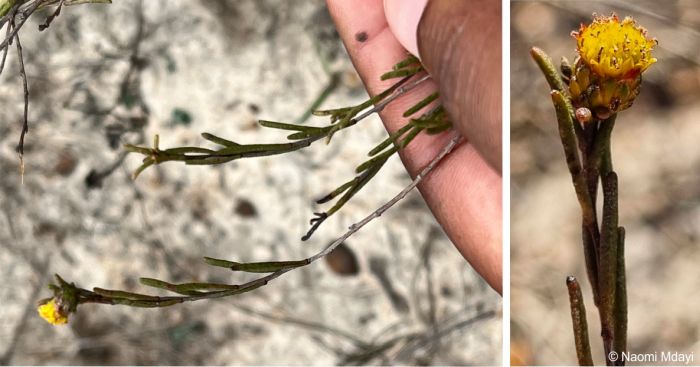
Conservation Status
Status
Marasmodes defoliata is assessed as Critically Endangered (CR) by the Red List of South African Plants. All members of the Marasmodes genus are threatened. This species is on the brink of extinction, primarily due to extensive historical and ongoing habitat loss caused by agricultural and urban expansion, as well as the infestation of alien invasive plants. Additionally, poor management of the remaining small habitat fragments where this species occurs has been identified as a contributing factor to its continued decline. In terms of conservation efforts, M. defoliata is found in a protected area, the Riverlands Nature Reserve, where the Millennium Seed Bank Partnership team has collected seeds for banking. These seeds are being processed and stored in SANBI’s Wild Plant Seed Bank at the Kirstenbosch National Botanical Garden. This ensures that the limited number of seeds available will serve as a backup in case the species goes extinct in the wild. Furthermore, a study is underway to develop germination protocols for all threatened species of Marasmodes, providing hope for future restoration efforts.
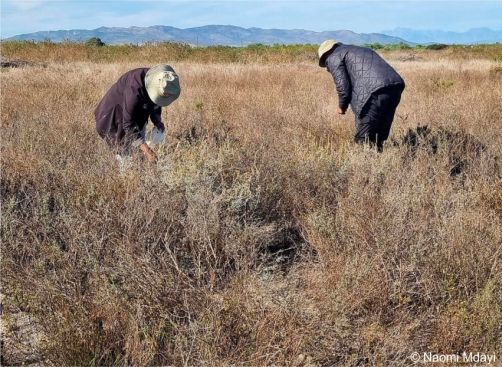
Distribution and habitat
Distribution description
Marasmodes defoliata is endemic to the Western Cape Province, South Africa. It has only been recorded in the Riverlands Nature Reserve near Malmesbury, where it occurs in Atlantis Sand Fynbos on seasonally moist, lowland acidic sands in flat areas.
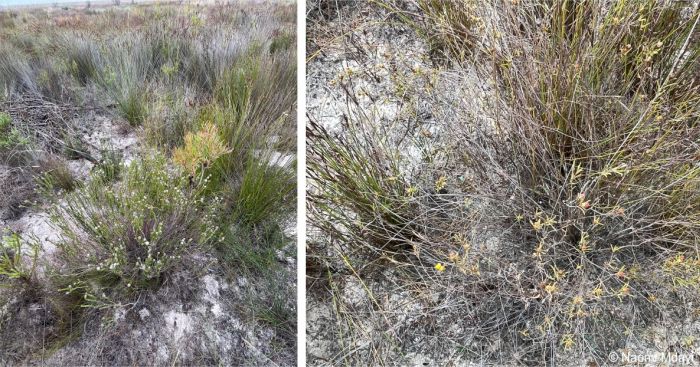
Derivation of name and historical aspects
History
The genus Marasmodes is distinguished from its close relatives Cymbopappus and Pentzia by its inconspicuous woody habit, sclerophyllous ericoid leaves, sessile discoid flower heads, and a pappus consisting of more than seven scales. Historically, conservation efforts for Marasmodes have been hindered by limited collections and taxonomic ambiguities. This is the only genus within the Asteraceae family in which all species are threatened.
The genus name, established by A.P. de Candolle in 1838, originates from the Greek word marasmos, meaning ‘withering’ or ‘decay’. This likely references the often inconspicuous or desiccated appearance of these plants in their natural environment. The species name defoliata is derived from Latin, meaning ‘devoid of leaves’ or ‘leafless’. This describes the plant’s deciduous (caducous) leaves, which are shed seasonally, leaving its stems exposed.
Marasmodes defoliata is distinguishable from the other species of the genus by its long, linear, caducous leaves. It has a large, campanulate capitulas with purple scarious phyllary tips. It is different from the closely related species Marasmodes macrocephala, which has larger leaves and capitula with obconical involucres.
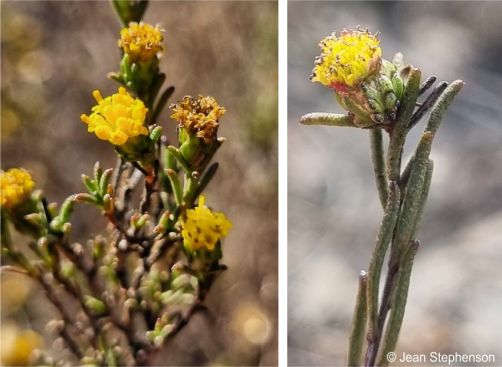
Ecology
Ecology
The species of Marasmodes are unusual in their flowering pattern, as they bloom during the dry autumn months, preceding the winter rains of the Cape Floristic Region. This contrasts with most plants in the region, which typically flower in response to the winter rains. In addition, their inconspicuous habit and small, discoid inflorescences make them cryptic in spring time when most of other plants are in bloom. As a result, they have been historically poorly collected and presently they are still easily overlooked in field surveys for environmental impact assessments, which are generally focused on the spring peak flowering season, resulting in ongoing loss of populations. As part of the fynbos biome, M. defoliata contributes to the biodiversity of this globally recognized biodiversity hotspot. Its presence in winter-wet flats suggests it may play a role in stabilizing soils and supporting local micro-ecosystems. Marasmodes species are pollinated by small flies and bees. Each tiny flower produces 2 to 3 viable seeds, which are dispersed by the wind, like other daisy shrubs. The plant's small, tough leaves discourage most browsers, though animals may feed on the tender new growth during spring.
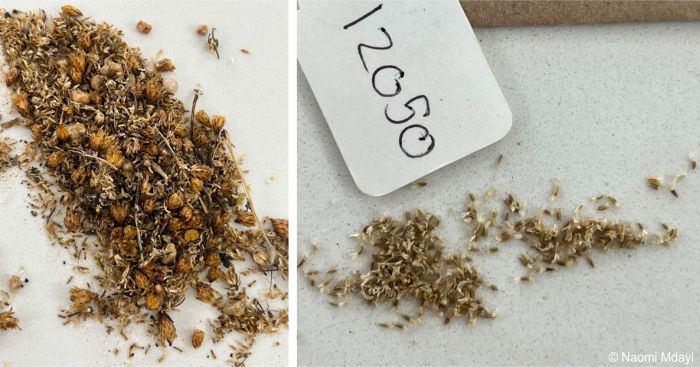
Uses
Use
Marasmodes defoliata has potential as an ornamental plant in the landscape and horticultural industries. Its sparsely branched habit and bright yellow flowers can do well in renosterveld, fynbos or Mediterranean-climate gardens. It can be interplanted with other low shrubs to make it stand out.
Growing Marasmodes defoliata
Grow
Marasmodes defoliata can be propagated through cuttings. Collect cuttings from the wild and place them in a wet plastic collecting bag. Take a propagating tray and fill it with a propagation mix consisting of fynbos sand and milled bark. Using a fine rose spray, drench the mix using a broad spectrum contact insectide solution to eliminate any pathogens from the soil, and let it drain. Make cuttings of about 5-7 cm long. Cut the tips off and remove leaves 1-2 cm from the bases. Also remove any flowers and developing buds. Dip the base of the cutting in a suitable rooting hormone which contains Auxin. Using a pencil, make a hole in the propagation mix, place your cutting and then carefully cover it. Place your cuttings in a propagation tunnel, with normal temperature and watered every 30 minutes.
References
- Cowell, C. 2010. Marasmodes DC (Asteraceae). PlantZAfrica. Online. http://pza.sanbi.org/marasmodes
- Ebrahim, I. 2009. Marasmodes day. Veld and Flora 95: 130, 131.
- Jackson, W.P.U. 1990. Origins and meanings of names of South African plant genera. University of Cape Town.
- Magee, A.R., Ebrahim, I., Koopman, R. & von Staden, L. 2017. Marasmodes (Asteraceae, Anthemideae), the most threatened plant genus of the Cape Floristic Region, South Africa: conservation and taxonomy. South African Journal of Botany 111: 371–386.
- Manning, J. & Goldblatt, P. 2012. Plants of the Greater Cape Floristic Region 1: the Core Cape Flora. Strelitzia 29. South African National Biodiversity Institute, Pretoria.
- Mdayi, N. 2019. Marasmodes trifida S.Ortiz. (Asteraceae). PlantZAfrica. Online. https://pza.sanbi.org/marasmodes-trifida.
- Mdayi, N. 2023. Marasmodes dummeri Bolus ex Hutch. (Asteraceae). PlantZAfrica. Online. https://pza.sanbi.org/marasmodes-dummeri.
- Ortiz, S. 2009. Eight new species of Marasmodes (Asteraceae, Anthemideae) from South Africa. Botanical Journal of the Linnean Society 159: 330–342.
- Raimondo, D., von Staden, L., Ebrahim, I. & Magee, A.R. 2016. Marasmodes dummeri Bolus ex Hutch. National Assessment: Red List of South African Plants. http://redlist.sanbi.org/species.php?species=3024-15.
Credits
Naomi Mdayi
Millennium Seed Bank Partnership
January 2025
Acknowledgements: the author thanks Kamogelo Modimola for sharing his expertise on the propagation of Marasmodes species, Sphephelo Kheswa for his valuable assistance with the distribution information of this plant, and special thanks to Jean Stephenson for kindly granting permission to use some of her photographs for this article.
Plant Attributes:
Plant Type: Shrub
SA Distribution: Western Cape
Soil type: Sandy
Flowering season: Autumn
PH: Acid
Flower colour: Yellow
Aspect: Full Sun
Gardening skill: Challenging
Special Features:
Horticultural zones
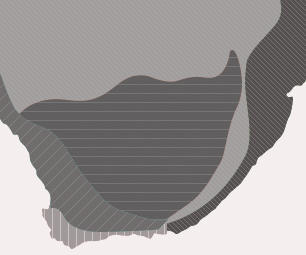






Rate this article
Article well written and informative
Rate this plant
Is this an interesting plant?
Login to add your Comment
Back to topNot registered yet? Click here to register.